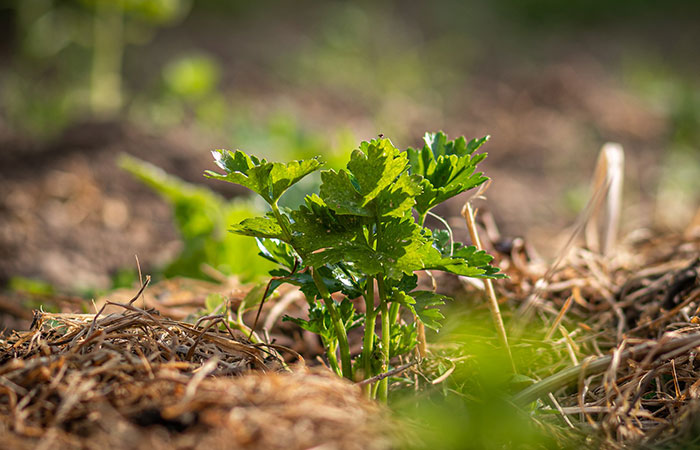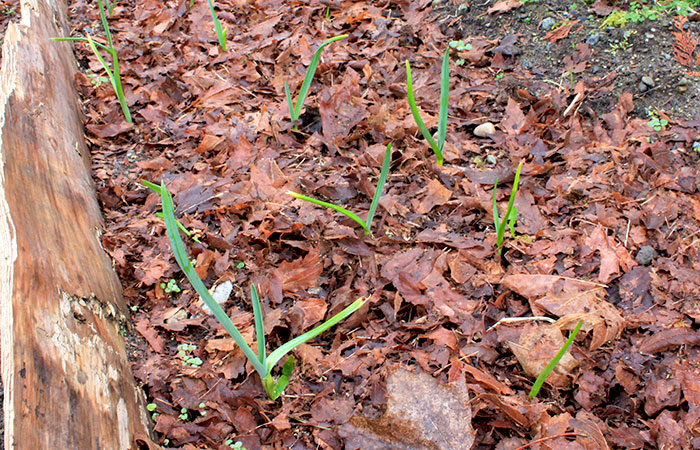Mulch for the Fall Garden
We talk a lot about mulch around here. Here’s what we mean by that, and why fall is the perfect time to mulch your garden.
What the heck is “mulch” anyway?

We get a lot of confused looks when we first introduce the idea of “mulch” to gardeners, but there’s really nothing all that mysterious about it: It’s just anything that you put on top of your soil. The same word can also be used as a verb: “mulching” refers to the process of putting down a layer of mulch.
We recommend mulches made of organic matter like bark, leaves, straw, or compost for most purposes, and we carry a large selection of options. These mulches can help protect soil and plant roots from rain and cold, provide habitat for friendly organisms that improve the soil, and suppress weeds. Although mulch is not a replacement for fertilizer, organic mulches can also gradually add nutrients to the soil over time.
Inorganic mulches such as decorative stones can also be used for aesthetic purposes, but they don’t supply the same benefits to the soil that organic mulches do.
Why mulch the fall garden?
Mulch can be used at any time of year, but the many benefits of mulching in the fall make this a particularly good time to give your garden some a nice cozy blanket of organic matter. Here are four reasons to mulch in the fall:
1. Protect from pounding winter rain
Our typically heavy winter rainfall can lead to soil becoming compacted. This makes the soil difficult for gardeners to work with, and harms the soil ecosystems that help garden plants thrive. Natural soil ecosystems have dense plant canopies and thick layers of fallen leaves and other debris to protect them. Gardeners who follow Mother Nature’s example by covering their soil in a protective mulch blanket for the winter will find that their soil is fluffier, easier to work with, and more full of life come spring.
2. Insulate plants and soil from cold weather
Soil microorganisms and plant roots alike benefit from a layer of insulation from the cold winter air. Mulch acts just like a blanket to regulate the temperature of the soil, keeping it more stable and protecting against hard freezes. It is especially important to mulch around tender perennials and other plants that are especially sensitive to cold, but all plants will benefit from a winter mulch blanket.
3. Suppress weeds
Weeds won’t grow much over the winter, but they are sure to pop their heads up with a vengeance as soon as soon as the weather starts to warm. Adding a layer of mulch won’t completely stop them, but it will suppress them and give you a head start on the next weeding season.
4. Provide habitat for friendly organisms
Healthy soil is alive, and soil organisms love decomposing organic matter. Adding a layer of mulch in the fall provides habitat and nutrients for all kinds of microbes, fungi, worms, and other little critters that are important parts of a thriving soil ecosystem.
Fall Mulching Tips

Use the right stuff
Loose, fluffy mulches are ideal for soil protection and insulation. Maple leaves and straw make particularly good insulating mulches, and they both tend to be readily available this time of year. These can be placed over a layer of compost, or combined with other forms of protective mulch such as newspaper or burlap.
Be cautious when sourcing straw, because some growers may treat it with herbicides that can harm garden plants. Sky Nursery’s straw is grown locally by Veriflora certified F&B Farms, and is free of these harmful herbicides.
Put it where it's needed
It’s only necessary to mulch soil that would otherwise be bare. Any visible plants that are already growing, including cover crops and groundcovers, essentially act as a “living mulch” that provides the same benefits.
A little goes a long way
There’s generally no reason to pile on inches and inches of mulch. Although fluffy mulches such as leaves will compact down over the winter, one or two inches is usually plenty for most purposes. Keeping your mulch layer reasonably thin will also make it easier to move aside and plant through in the spring if needed.
Leave space around fall plants
Don’t smother your plant stems! It’s important to leave at least an inch or two of space between stems of woody trees, shrubs, and perennials when mulching.
